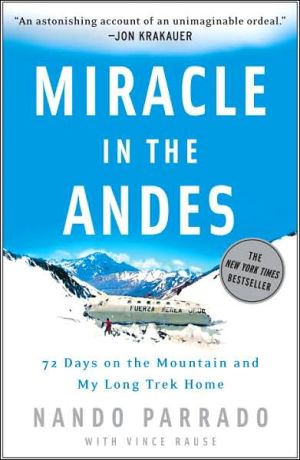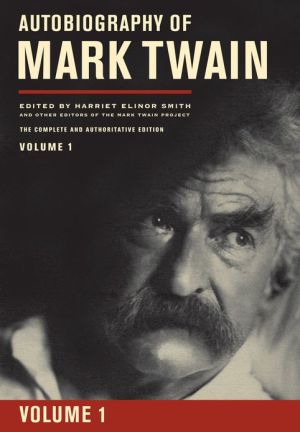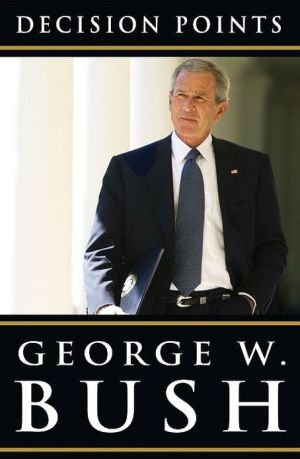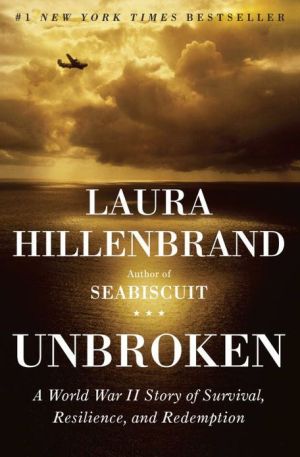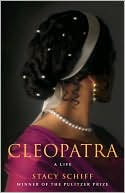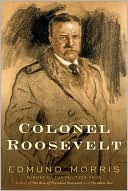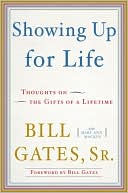Miracle in the Andes: 72 Days on the Mountain and My Long Trek Home
In the first hours there was nothing, no fear or sadness, just a black and perfect silence.\ Nando Parrado was unconscious for three days before he woke to discover that the plane carrying his rugby team, as well as their family members and supporters, to an exhibition game in Chile had crashed somewhere deep in the Andes. He soon learned that many were dead or dying—among them his own mother and sister. Those who remained were stranded on a lifeless glacier at nearly 12,000 feet above sea...
Search in google:
In the first hours there was nothing, no fear or sadness, just a black and perfect silence.Nando Parrado was unconscious for three days before he woke to discover that the plane carrying his rugby team, as well as their family members and supporters, to an exhibition game in Chile had crashed somewhere deep in the Andes. He soon learned that many were dead or dying among them his own mother and sister. Those who remained were stranded on a lifeless glacier at nearly 12,000 feet above sea level, with no supplies and no means of summoning help. They struggled to endure freezing temperatures, deadly avalanches, and then the devastating news that the search for them had been called off. As time passed and Nando s thoughts turned increasingly to his father, who he knew must be consumed with grief, Nando resolved that he must get home or die trying. He would challenge the Andes, even though he was certain the effort would kill him, telling himself that even if he failed he would die... The Washington Post - Tahir Shah Miracle in the Andes tells much the same story as is recounted in Alive, published more than 30 years ago. The difference is that this book contains a level of emotion only a firsthand account can provide. Parrado's narrative paints the terrible tale in vivid colors for the first time. It would be hard to find another book written with such engaging sensitivity and, at the same time, so charged with sheer humanity. Parrado's extraordinary quality is to remind those of us living within the firm safety net of society that we are all capable of pushing ourselves to the limit. But more important, it teaches us not to waste a single moment, or a single breath.
Chapter One\ Before\ It was Friday, the thirteenth of October. We joked about that—flying over the Andes on such an unlucky day, but young men make those kinds of jokes so easily. Our flight had originated one day earlier in Montevideo, my hometown, its destination Santiago, Chile. It was a chartered flight on a Fairchild twin-engine turboprop carrying my rugby team—the Old Christians Rugby Club—to play an exhibition match against a top Chilean squad. There were forty-five people aboard, including four crew members—pilot, copilot, mechanic, and steward. Most of the passengers were my teammates, but we were also accompanied by friends, family members, and other supporters of the team, including my mother, Eugenia, and my younger sister, Susy, who were sitting across the aisle and one row in front of me. Our original itinerary was to fly nonstop to Santiago, a trip of about three and a half hours. But after just a few hours of flying, reports of bad weather in the mountains ahead forced the Fairchild’s pilot, Julio Ferradas, to put the plane down in the old Spanish colonial town of Mendoza, which lies just east of the Andean foothills.\ We landed in Mendoza at lunchtime with hopes that we would be back in the air in a few hours. But the weather reports were not encouraging, and it was soon clear that we would have to stay the night. None of us liked the idea of losing a day from our trip, but Mendoza was a charming place, so we decided to make the best of our time there. Some of the guys relaxed in sidewalk cafés along Mendoza’s broad, tree-lined boulevards or went sightseeing in the city’s historic neighborhoods. I spent the afternoon with some friends watching an auto race at a track outside of town. In the evening we went to a movie, while some of the others went dancing with some Argentinean girls they had met. My mother and Susy spent their time exploring Mendoza’s quaint gift shops, buying presents for friends in Chile and souvenirs for the people at home. My mother was especially pleased to find a pair of red baby shoes in a small boutique, which she thought would make the perfect gift for my sister Graciela’s new baby boy.\ Most of us slept late the next morning, and when we woke we were anxious to leave, but there was still no word about our departure, so we all went our separate ways to see a little more of Mendoza. Finally we received word to gather at the airport at 1:00 p.m. sharp, but we arrived only to discover that Ferradas and his copilot, Dante Lagurara, had not yet decided whether or not we would fly. We reacted to this news with frustration and anger, but none of us understood the difficult decision confronting the pilots. The weather reports that morning warned of some turbulence along our flight path, but after speaking with the pilot of a cargo plane that had just flown in from Santiago, Ferradas was confident the Fairchild could fly safely above the weather. The more troubling problem was the time of day. It was already early afternoon. By the time the passengers were boarded and all the necessary arrangements were made with airport officials, it would be well past two o’clock. In the afternoon, warm air rises from the Argentine foothills and meets the frigid air above the snowline to create treacherous instability in the atmosphere above the mountains. Our pilots knew that this was the most dangerous time to fly across the Andes. There was no way to predict where these swirling currents might strike, and if they got hold of us, our plane would be tossed around like a toy.\ On the other hand, we couldn’t stay put in Mendoza. Our aircraft was a Fairchild F-227 that we had leased from the Uruguayan air force. The laws of Argentina forbade a foreign military aircraft to stay on Argentine soil longer than twenty-four hours. Since our time was almost up, Ferradas and Lagurara had to make a fast decision: should they take off for Santiago and brave the afternoon skies, or fly the Fairchild back to Montevideo and put an end to our vacation?\ As the pilots pondered the options, our impatience grew. We had already lost a day of our Chilean trip, and we were frustrated by the thought of losing more. We were bold young men, fearless and full of ourselves, and it angered us that our vacation was slipping away because of what we regarded as the timidity of our pilots. We did not hide these feelings. When we saw the pilots at the airport, we jeered and whistled at them. We teased them and questioned their competence. “We hired you to take us to Chile,” someone shouted, “and that’s what we want you to do!” There is no way to know whether or not our behavior influenced their decision—it did seem to unsettle them—but finally, after one last consultation with Lagurara, Ferradas glanced around at the crowd waiting restlessly for an answer, and announced that the flight to Santiago would continue. We greeted this news with a rowdy cheer.\ The Fairchild finally departed from Mendoza Airport at eighteen minutes after two o’clock, local time. As we climbed, the plane banked steeply into a left turn and soon we were flying south, with the Argentine Andes rising to our right on the western horizon. Through the windows on the right side of the fuselage, I gazed at the mountains, which thundered up from the dry plateau below us like a black mirage, so bleak and majestic, so astonishingly vast and huge, that the simple sight of them made my heart race. Rooted in massive swells of bedrock with colossal bases that spread for miles, their black ridges soared up from the flatlands, one peak crowding the next, so that they seemed to form a colossal fortress wall. I was not a poetically inclined young man, but there seemed to be a warning in the great authority with which these mountains held their ground, and it was impossible not to think of them as living things, with minds and hearts and an old brooding awareness. No wonder the ancients thought of these mountains as holy places, as the doorstep to heaven, and as the dwelling place of the gods.\ Uruguay is a low-lying country, and like most of my friends on the plane, my knowledge of the Andes, or of any mountains at all, was limited to what I had read in books. In school we learned that the Andes range was the most extensive mountain system in the world, running the length of South America from Venezuela in the north to the southern tip of the continent in Tierra del Fuego. I also knew that the Andes are the second-highest mountain range on the planet; in terms of average elevation, only the Himalayas are higher.\ I had heard people refer to the Andes as one of the earth’s great geological wonders, and the view from the airplane gave me a visceral understanding of what that meant. To the north, south, and west, the mountains sprawled as far as the eye could see, and even though they were many miles away, their height and mass made them seem impassable. In fact, as far as we were concerned, they were. Our destination, Santiago, lies almost exactly due west of Mendoza, but the region of the Andes that separates the two cities is one of the highest sections of the entire chain, and home to some of the tallest mountains in the world. Somewhere out there, for example, was Aconcagua, the highest mountain in the Western Hemisphere and one of the seven tallest on the planet. With a summit of 22,831 feet, it stands just 6,200 feet shy of Everest, and it has giants for neighbors, including the 22,000-foot Mount Mercedario, and Mount Tupongato, which stands 21,555 feet tall. Surrounding these behemoths are other great peaks with elevations of between 16,000 and 20,000 feet, which no one in those wild reaches had ever bothered to name.\ With such towering summits rising along the way, there was no chance that the Fairchild, with its maximum cruising altitude of 22,500 feet, could fly a direct east-west route to Santiago. Instead, the pilots had charted a course that would take us about one hundred miles south of Mendoza to Planchón Pass, a narrow corridor through the mountains with ridges low enough for the plane to clear. We would fly south along the eastern foothills of the Andes with the mountains always on our right, until we reached the pass. Then we’d turn west and weave our way through the mountains. When we had cleared the mountains on the Chilean side, we would turn right and fly north to Santiago. The flight should take about an hour and a half. We would be in Santiago before dark.\ On this first leg of the trip, the skies were calm, and in less than an hour we had reached the vicinity of Planchón Pass. I didn’t know the name of the pass, of course, or any of the flight details. But I couldn’t help noticing that after flying for miles with the mountains always off in the western distance, we had banked to the west and were now flying directly into the heart of the cordillera. I was sitting in a window seat on the left side of the plane, and as I watched, the flat, featureless landscape below seemed to leap up from the earth, first to form rugged foothills, then heaving and buckling up into the awesome convolutions of true mountains. Shark-finned ridges raised themselves up like soaring black sails. Menacing peaks pushed up like gigantic spearheads or the broken blades of hatchets. Narrow glacial valleys gashed the steep slopes, forming rows of deep, winding, snow-packed corridors that stacked and folded one upon the other to create a wild, endless maze of ice and rock. In the Southern Hemisphere, winter had given way to early spring, but in the Andes, temperatures still routinely dipped to 35 degrees below zero Fahrenheit, and the air was as dry as a desert. I knew that avalanches, blizzards, and killing gale-force winds were common in these mountains, and that the previous winter had been one of the most severe on record, with snowfalls, in some places, of several hundred feet. I saw no color at all in the mountains, just muted patches of black and gray. There was no softness, no life, only rock and snow and ice and as I looked down into all that rugged wildness, I had to laugh at the arrogance of anyone who had ever thought that human beings have conquered the earth.\ Watching out the window, I noticed that wisps of fog were gathering, then I felt a hand on my shoulder.\ “Switch seats with me, Nando. I want to look at the mountains.”\ It was my friend Panchito, who was sitting in the aisle seat beside me. I nodded and rose from my seat. When I stood to change places someone yelled, “Think fast, Nando!” and I turned just in time to catch a rugby ball someone had tossed from the rear of the cabin. I passed the ball forward, and then sank into my seat. All around us there was laughing and talking, people were moving from seat to seat, visiting friends up and down the aisle. Some friends, including my oldest amigo, Guido Magri, were in the back of the plane playing cards with some crew members, including the flight steward, but when the ball began bouncing around the cabin, the steward stepped forward and tried to calm things down. “Put the ball away,” he shouted. “Settle down, and please take your seats!” But we were young rugby players traveling with our friends, and we did not want to settle down. Our team, the Old Christians from Montevideo, was one of the best rugby teams in Uruguay, and we took our regular matches seriously. But in Chile we would be playing an exhibition match only, so this trip was really a holiday for us, and on the plane there was the feeling that the holiday had already begun.\ It was a fine thing to be traveling with my friends, these friends especially. We had been through so much together—all the years of learning and training, the heartbreaking losses, the hard-fought wins. We had grown up as teammates, drawing from each other’s strengths, learning to trust one another when the pressure was on. But the game of rugby had not only shaped our friendships, it had shaped our characters, and brought us together as brothers.\ Many of us on the Old Christians had known each other for more than ten years, since our days as schoolboy ruggers playing under the guidance of the Irish Christian Brothers at the Stella Maris School. The Christian Brothers had come to Uruguay from Ireland in the early 1950s, at the invitation of a group of Catholic parents who wanted them to found a private Catholic school in Montevideo. Five Irish Brothers answered the call, and in 1955 they created the Stella Maris College, a private school for boys between the ages of nine and sixteen, located in the Carrasco neighborhood, where most of the students lived.\ For the Christian Brothers, the first goal of a Catholic education was to build character, not intellect, and their teaching methods stressed discipline, piety, selflessness, and respect. To promote these values outside the classroom, the Brothers discouraged our natural South American passion for soccer—a game that, in their view, fostered selfishness and egotism—and steered us toward the rougher, earthier game of rugby. For centuries, rugby had been an Irish passion, but it was virtually unknown in our country. At first the game seemed strange to us—so brutal and painful to play, so much pushing and shoving and so little of soccer’s wide-open flair. But the Christian Brothers firmly believed that the qualities required to master the sport were the same characteristics one needed to live a decent Catholic life—humility, tenacity, self-discipline, and devotion to others—and they were determined that we would play the game and play it well. It did not take us long to learn that once the Christian Brothers set their minds to a purpose, there was little that could sway them. So we set aside our soccer balls and acquainted ourselves with the fat, pointed pigskin used in rugby.\ In long, tough practices on the fields behind the school, the Brothers started from scratch, drilling us in all the rugged intricacies of the game—mucks and rauls, scrumdowns and lineouts, how to kick and pass and tackle. We learned that rugby players wore no pads or helmets, but still we were expected to play aggressively and with great physical courage. But rugby was more than a game of brute strength; it required sound strategy, quick thinking, and agility. Most of all the game demanded that teammates develop an unshakeable sense of trust. They explained that when one of our teammates falls or is knocked to the ground, he “becomes grass.” This was their way of saying that a downed player can be stomped on and trampled by the opposition as if he were part of the turf. One of the first things they taught us was how to behave when a teammate becomes grass. “You must become his protector. You must sacrifice yourself to shield him. He must know he can count on you.”\ From the Hardcover edition.
Prologue 1Before 5Everything Precious 33A Promise 45Breathe Once More 73Abandoned 101Tomb 127East 143The Opposite of Death 179"I See a Man..." 205After 237Epilogue 267A Note on Photographs 285Acknowledgments 286
\ From Barnes & NobleImagine a real-life Lost where personal survival replaces viewer suspense. On the morning of October 12, 1972, a plane crashed into an inaccessible region of the Argentine Andes. For 72 harrowing days, the survivors, most of them members of a top Uruguayan rugby team, fought to stay alive on a windy glacier without food, blankets, warm clothing, or means of communicating with the outside world. For more than two months, they struggled against hunger, forcing themselves to eat strips of leather and, eventually, human flesh stripped from their dead colleagues. The survivors' plight was rendered in Piers Paul Read's 1974 Alive and the 1993 film with the same title, but no previous account can match this intense first-person narrative.\ \ \ \ \ Tahir ShahMiracle in the Andes tells much the same story as is recounted in Alive, published more than 30 years ago. The difference is that this book contains a level of emotion only a firsthand account can provide. Parrado's narrative paints the terrible tale in vivid colors for the first time. It would be hard to find another book written with such engaging sensitivity and, at the same time, so charged with sheer humanity. Parrado's extraordinary quality is to remind those of us living within the firm safety net of society that we are all capable of pushing ourselves to the limit. But more important, it teaches us not to waste a single moment, or a single breath.\ — The Washington Post\ \ \ Publishers WeeklyIn October 1972, a plane carrying an Uruguayan rugby team crashed in the Andes. Not immediately rescued, the survivors turned to cannibalism to survive and after 72 days were saved. Rugby team member Parrado has written a beautiful story of friendship, tragedy and perseverance. High in the Andes, with a fractured skull, eating the flesh of his teammates and friends, Parrado calmly ponders the cruelties of fate, the power of the natural world and the possibility of continued existence. "I would live from moment to moment and from breath to breath, until I had used up all the life I had." Parrado, who for the past 10 years has been giving inspirational talks based on his experiences, lost his mother and sister in the crash. Struggling to stay alive, his guide becomes his beloved father: "each [stride] brought me closer to my father... each step I took was a step stolen back from death." More than a companion to the 1970s bestselling chronicle of the disaster, Alive, this is a fresh, gripping page-turner that will satisfy adventure readers, and a complex reflection on camaraderie, family and love. Photos. First serial in Outside. (May 9) Copyright 2006 Reed Business Information.\ \ \ \ \ Library JournalIn October 1972, Uruguayan rugby player Parrado awoke bewildered, freezing, and wracked with pain, finding himself stranded high in the Andes, one of numerous survivors of the crash of the airplane that had been carrying his rugby team to Chile. With little food or warm clothing, suffering from a head injury, and grieving the deaths of family members and friends, Parrado, with the other survivors, was plunged into a harrowing life-or-death struggle. Over 30 years later, he explains that he found the means to persevere through his deep love for his father, which enabled him to endure subzero temperatures, deadly avalanches, and the gruesome necessity of cannibalism. Contemplative yet unflinching, this thought-provoking work is both a gripping survival story and a sensitive examination of the sustaining power of religious faith, friendship, love, and family ties. More introspective than Piers Paul Read's journalistic account, Alive, published soon after the ordeal, Parrado presents both the jaw-dropping realities of the 16 survivors' story and the life-altering lessons he learned from the experience. With its universal themes of courage and determination and its broad appeal to true-adventure fans, this work is recommended for all public libraries.-Ingrid Levin, Florida Atlantic Univ., Jupiter Copyright 2006 Reed Business Information.\ \ \ \ \ School Library JournalAdult/High School-In 1972, Parrado and his rugby teammates from Uruguay were flying to Chile to play a match against the national team. Crossing the Andes, the aircraft crashed on a remote, high-altitude, glaciated slope. This remarkable story of the survivors omits none of the raw intensity and brutality of their experience but is burnished by time, casting an analytical perspective on ways in which their subsequent lives were influenced by the ordeal. The many forms of courage exhibited and the sustaining power of love of family are the basis of the narrative as the group supported one another in a collective "refusal to surrender to the mountain." Parrado credits their physical conditioning and the rigorous team ethic inherent in the sport as the foundation for the trust and allegiance that enabled the men to battle the odds. Reduced to the most elemental human needs and learning from a radio transmission that rescue efforts had been abandoned, they reluctantly realized that their only food source was the bodies of the victims. Parrado was respectful of the spiritual faith of those who clung to a belief in rescue, but put his energy into engineering a plan and acted as a leader of the "expeditionaries" who hiked through the perilous mountains to find help. A detailed chronicle of these events was presented in Piers Paul Read's Alive (Avon, 1975), but Parrado's memoir offers a reflective expansion of that work. Dramatic photographs are included.-Lynn Nutwell, Fairfax City Regional Library, VA Copyright 2006 Reed Business Information.\ \ \ \ \ Kirkus ReviewsIntense memoir of epic survival that both shocked and thrilled a worldwide audience. Piers Paul Read's Alive was an international bestseller based on the 1972 ordeal of Uruguayan survivors of a plane crash high in the Andes mountains. Now Parrado, one of the members of that Montevideo rugby club, who was instrumental in the story's outcome, sets down his personal recollections for the first time. The bare facts remain gripping: In October, 45 passengers and crew, comprising the team, family members and fans departed Mendoza, Argentina, bound for Santiago, Chile, in a chartered twin-engine turboprop plane. The plane, traveling through turbulent mountain passes in lowering visibility, crashed into a peak and came to rest in a glacial snow field at an altitude of about 12,000 feet. There were 32 survivors, some terminally injured. Parrado's harrowing account details the burial of his mother, dead on impact, and later his sister, who died of internal injuries; meanwhile, the group, without heavy clothing (some had never seen snow before) or any source of food, set about improvising for survival on the freezing mountain. They cared for injured teammates, watched others die and finally made the agonizing decision that the bodies were, indeed, their only potential source of food-hence the sensational reaction to the original story. After two months, Parrado, who sustained a skull fracture, and one companion were able to traverse some 70 miles of Andean terrain without any mountaineering equipment or know-how in order to contact rescuers in Chile, saving the remaining 16. The author claims to not have flashbacks, but his candid, vivid memories bring this nearly incredible story to life onceagain.\ \
